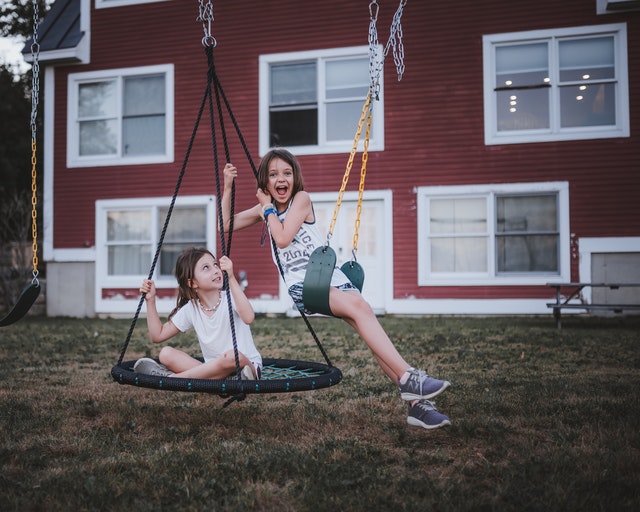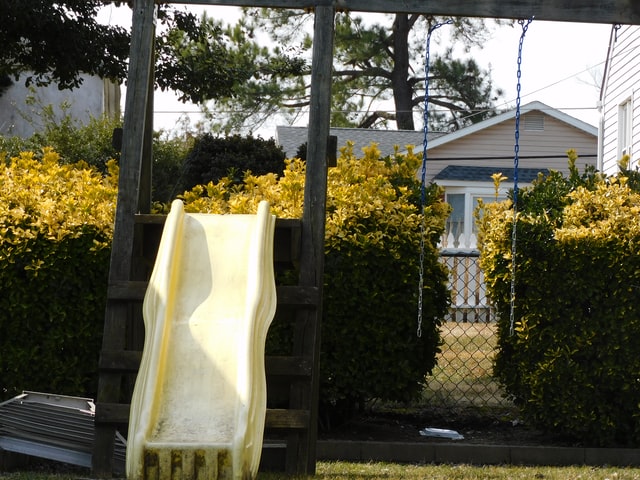If your home has a backyard, you can create an amazing playground that your kids will love. Exercising and spending time outdoors is important for encouraging healthy childhood mental and physical development. Outdoor play allows children to explore, be creative, and stay active. Building a fun and engaging backyard playground can provide endless hours of entertainment and activity for the little ones.
Benefits of outdoor play for children
Outdoor play promotes physical health, cognitive development, and emotional well-being. According to a study by the American Academy of Pediatrics, outdoor play helps reduce the risk of obesity and improves overall fitness levels in children. Natural light and fresh air exposure can enhance mood and reduce stress levels. Outdoor play encourages creativity, imagination, and social skills as children engage in unstructured activities and interact with their peers. Providing opportunities for outdoor play is vital for fostering a healthy and balanced lifestyle for children.
Planning your backyard playground
Before buying swing sets and other playground equipment, it’s important to do key things in advance. Here are some planning tips to help you get started:
Measure your backyard dimensions
You wouldn’t buy a new sofa without measuring your living room first. The same principle applies to your backyard. Measure your yard in length and width, taking note of the total square footage. This will make it easier to divide the yard into sections and bring in the proper-sized equipment later.
Designating sections and games to include
If your backyard is large, consider dividing it into different play areas. For example, one corner could have a sandbox, while another could have monkey bars and a swing set. Don’t forget to include fun games and kids’ activities like giant outdoor building blocks, a ring toss game, or a cool climbing tower. You can purchase many pre-made backyard playground items or try to make them yourself using a few simple things you can obtain from your local hardware store.
Consider your children’s ages
When designing a backyard playground, it’s important to consider your kids’ ages. Younger children should use bucket-style swing sets for safety and only be allowed outside under adult supervision. Rock climbing walls and taller equipment should be reserved for older kids. Generally, the older your children are, the more complex and taller the playground equipment can be.
Get your kids involved in the process
Have your kids help you build their playground equipment and make the process fun. This is a great way to spend time together as a family, and it gives the kids a chance to provide their input on what type of things they’ll have in the backyard, where to put them, and what designs or colors they prefer.
Follow safety guidelines
When building a backyard playground, follow all safety guidelines regarding the structure, the materials used, and the rules for outdoor playtime. Never leave kids outside unsupervised, and make sure that no screws or nails are exposed to prevent injury. Once your equipment is in place, add at least a foot of shredded rubber, wood mulch, or fine sand all around the base to provide a “buffer” when kids fall or engage in rough play. Inspect all equipment often to ensure that it’s in good working order and that no sharp edges or hardware is exposed. Replace broken boards or any parts that are in disrepair.
Budgeting for your backyard playground
Another important aspect of the planning process of your backyard playground project is your budget. The total cost to install a backyard playground can range from around $2,000 up to $10,000 or more, depending on several factors:
- Playground equipment costs: These can range from $100 to $5,000, considering swing sets, slides, climbers, etc. Simple sets cost around $100, while more elaborate playsets cost $1,000 to $5,000.
- Site preparation: Clearing the area, leveling the ground, and installing a proper safety surface like rubber tiles, wood chips, or sand can cost $1,200 to $5,000.
- Installation labor: Hiring professionals to assemble and install the playground can cost $150 to $900. For simpler setups, DIY installation is possible.
- Permits and inspections: Depending on local regulations, permits and inspections can add $150 to $2,300 to the total cost.
Playground equipment to include
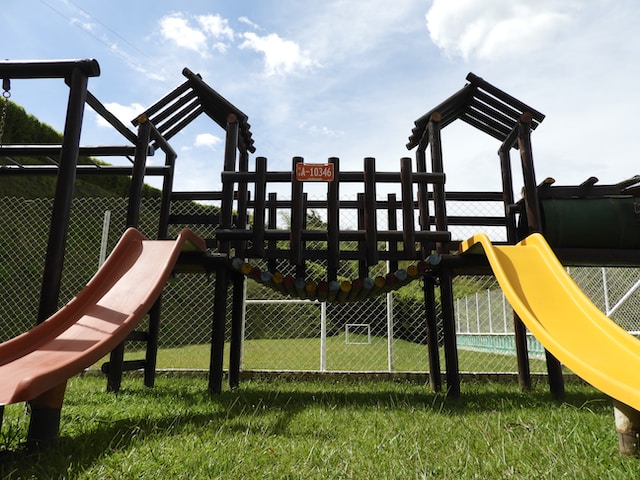
Here are some examples of popular playground sets and equipment you can include for an awesome experience:
- Slides: Every kid loves a slide, so fill your backyard playground with a few different slides at varying heights. Make sure you choose low slides for young kids. If you’re using metal slides, try to place them under a tree so they stay cool in the sun.
- Swings: From a classic swing set to a tree tire swing, every child loves swinging outside. You can purchase a complete vinyl playset or make your own and hang it from a tree. Consider installing a swingset base to prevent the swingset from tipping over.
- Treehouse: If you have the ability and the tools, you can make a custom DIY treehouse. Several plans are available online, or you can look for a pre-built treehouse that only requires attaching them to the tree securely. No matter how you build it, a homemade playhouse will be the best option for your kids.
- Castle: Every kid dreams of building a backyard fortress or castle. Look for pre-made castles or build your own using pieces of plywood. Remember to add windows and a drawbridge, too.
- Small pool: Kiddie pools offer a great way to cool off on hot summer days. You can find small pools of various sizes and shapes in the backyard. Fill the pool with clean water and let your kids splash their worries away.
- Clubhouse climber: A clubhouse climber features two clubhouses attached to a bridge or pathway. You can find these online at various retailers or attempt to make your own.
- More ideas: A few other popular playground sets or equipment items include monkey bars, seesaws, and teeter-totters; you can also buy the best outdoor playhouses and merry-go-rounds.
DIY backyard play area ideas
After your initial planning is done, it’s time to consider some fun and unique DIY backyard playground areas. Some things you can do yourself, but consider hiring a handyperson to help you build your perfect DIY playground.
Climbing structures
-
- Tire climbing tower: Create a custom climbing tower using heavy-duty lumber and some tires. Make sure the tires are in good condition and that each one is attached securely to the lumber using lag screws. Put the lumber at least two feet into the ground to keep it steady and prevent it from leaning or falling over.
- Rope and rock-climbing tower: Design a fun tower with rope climbing on one side and rock climbing on the other using a sturdy wooden A-frame. This DIY design is for older kids, but it’s a great way to keep them active and engage in some friendly competition with their siblings and friends. Attach the “rocks” (you can find these at most sporting goods stores) to the solid side using nuts, bolts, and long screws so they stay in place. You can design the back either by attaching a rope to several loops at the top of the wood or by making your climbing net from nylon rope.
Swings
-
- DIY wooden swing: A handmade swing is easy to make with just a few simple items. Attach small wood sections with braided nylon rope, separating each slat with a wooden bead to make the seat flexible. Just make sure the rope you use is heavy-duty so it stays together and securely attaches to the swing set frame.
- Homemade tire swing: Every kid loves a classic tire swing, and it’s an easy DIY backyard playground project. You only need a large tire, a tree with thick, sturdy branches, and high-quality rope. Wrap the rope around one end of the tire several times, then bring the two ends up and tie them onto the branch above. If you want to add a pop of color, coat the tire with outdoor spray paint for a fun touch.
Play area
-
- Sand play area: This is an easy play area to create. Simply fill a section of your yard with play sand and separate it using wooden timbers, large rocks, or a pre-made sandbox. Always make sure that the sand you use is specifically designed for kids to play in. Don’t forget to add some fun toys so the kids can enjoy hours of fun outside in the sand.
- Tire balance beam: Using recycled tires, create a simple DIY balance beam by burying each one about halfway into the ground. Place the tires in a straight line, ensuring they’re up against each other with no gaps in between. You can paint each tire a different color and watch your child get excited as they walk across each one until they reach the end.
Sensory and creative play
-
- DIY backyard sound wall: A sound wall is great for kids’ sense of touch, sight, and hearing. Simply attach a range of items to a wooden board, placing it at about eye level. You can add pots and pans, spinners, and anything else that makes noise as long as it’s weather-resistant.
Making your playground more sustainable
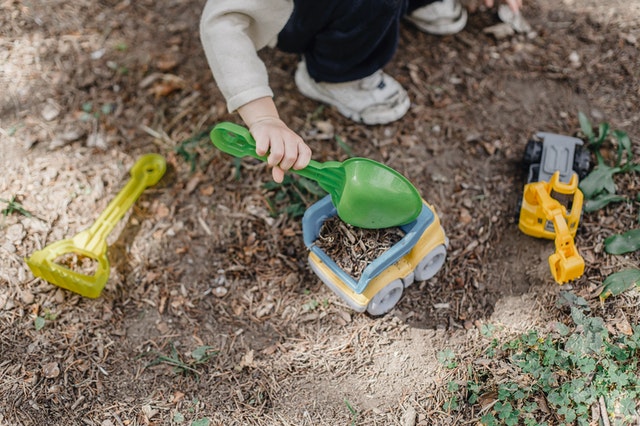
To create a sustainable backyard playground, choose eco-friendly materials, incorporate energy-efficient lighting, collect rainwater for irrigation, and plant native vegetation to attract wildlife. Using sustainable practices can reduce environmental impact and create a greener play space for your children.
-
-
- Eco-friendly materials: For your playground equipment, opt for recycled plastic and sustainably sourced wood. Paint with low volatile organic compounds to minimize air pollution and provide a healthier playing environment.
- Energy-efficient lighting: Install solar-powered lights to illuminate your playground, or use energy-efficient LED lights for your playground.
- Rainwater harvesting: Install rain barrels and build a rain garden to minimize stormwater runoff. These eco-friendly solutions help conserve water and contribute to a healthier local ecosystem for you and your family to enjoy.
- Native vegetation: Plant wildflower meadows and native vegetation to attract pollinators while adding visual appeal to your playground.
-
Safety and insurance considerations
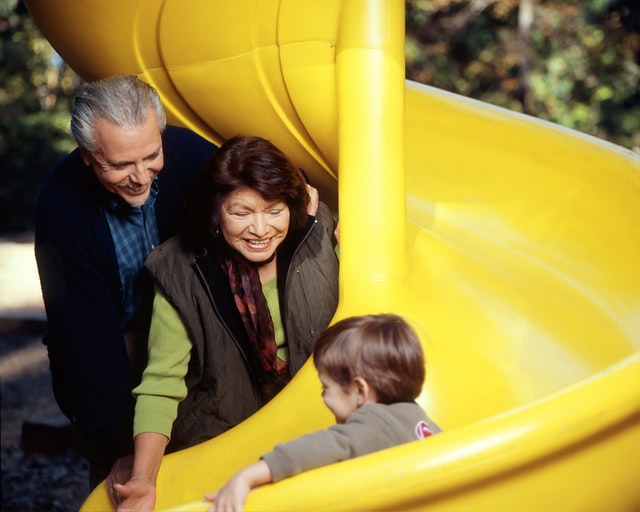
Just as you prioritize safety and enjoyment in your home, creating a backyard playground requires attention to detail and consideration for potential risks.
Choose the right safety measures
Prioritize safety features that meet safety standards and provide suitable protection for children. Consider the type of equipment, surfacing materials, and any additional features you wish to include to enhance safety. Invest in home insurance that specifically covers playground equipment and liability risks to ensure financial protection in case of accidents.
Understand playground safety guidelines
Familiarize yourself with playground safety guidelines and standards to ensure that your playground meets recommended safety requirements.
Assess playground equipment
Regularly check the condition of your playground equipment to verify that it is safe and in good working order. Check for any signs of wear and tear, loose components, or potential hazards that may pose a risk to children using the playground. Keeping detailed records of your playground equipment and its maintenance can also help in case of a claim with your home insurance provider.
Maintain proper maintenance
Carry out a regular maintenance schedule for your backyard playground to keep it in optimal condition. Inspect equipment, repair any damages promptly, and keep the playground area clean and free from debris to prevent accidents and injuries. Maintaining a well-maintained playground can also help reduce the risk of accidents and potential claims with your home insurance provider.
Understand liability concerns
Be aware of potential liability issues related to your backyard playground and consider additional insurance coverage or liability protection if necessary. Understanding your responsibilities as a homeowner and having a comprehensive home insurance policy that includes playground equipment coverage can help you reduce risks and maintain a safe environment for children playing in your backyard.
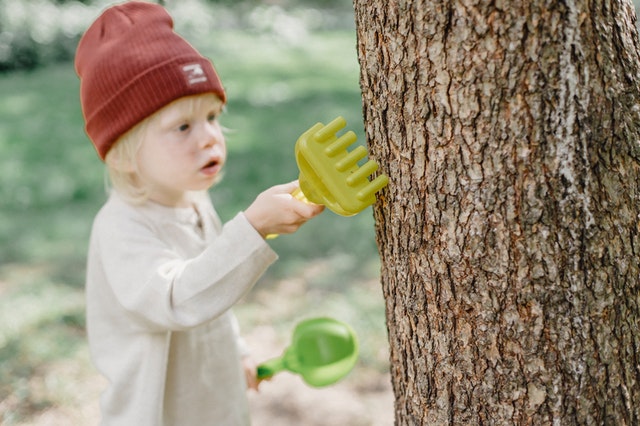
With some planning and some creativity, you can create an amazing playground right in your own backyard. From simple swings to rock climbing walls and castles, keep these tips in mind to help build the ultimate backyard playground. You’ll have a fantastic space for your kids to play, spend time outside, and use their imaginations for years to come.
